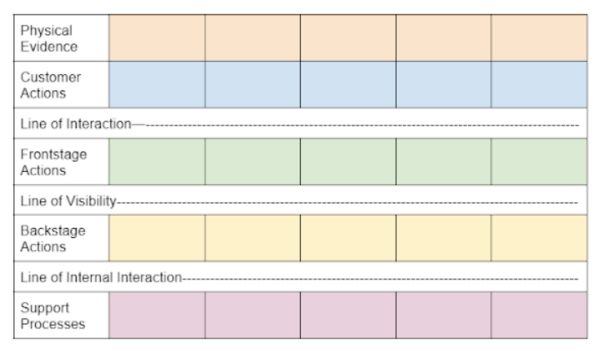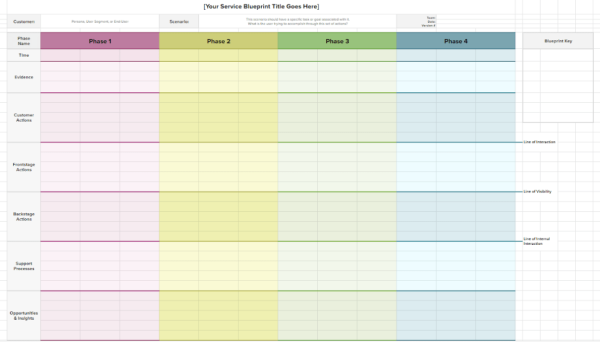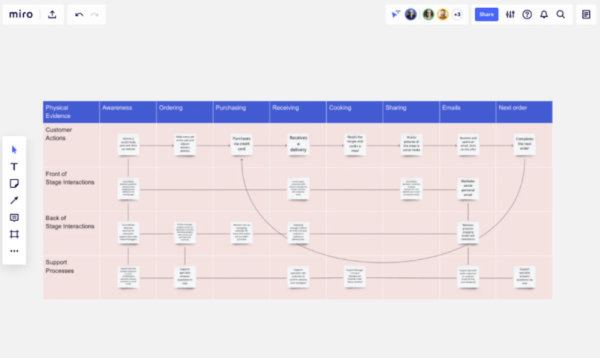A service blueprint template helps visualize steps that are part of the service process and takes the customer’s perspective into account. It makes design processes simple and improves the existing ones. To create one, map out each actor and process that’s part of the customer experience, from the third party to in-house vendors.
Service Blueprint vs Customer Journey Map
The main focus of a service blueprint is the documentation of the way an organization create an experience whereas the main focus of the customer journey map is learning more about an end user.
Elements of a Service Blueprint Template
A service blueprint template contains the following five elements
- Physical evidence such as websites, stores, emails, or receipts.
- Customer actions such as website visits, order placement, or asking a question.
- Frontstage actions like answering questions and sending emails
- Backstage actions like filling orders or writing websites.
- Support processes such as vendors that provide supplies or software or third-party delivery systems
When to use a Service Blueprint Template
Teams create templates to make knowledge transfer easy to a new member and across the team. You can reduce inefficiencies and silos by clarifying processes and roles. Templates enable you to compare competitors and services and to determine how a service functions currently and how you want it to function.
Service Blueprint Template Word
Service Blueprint Template Excel
Service Blueprint Template PowerPoint
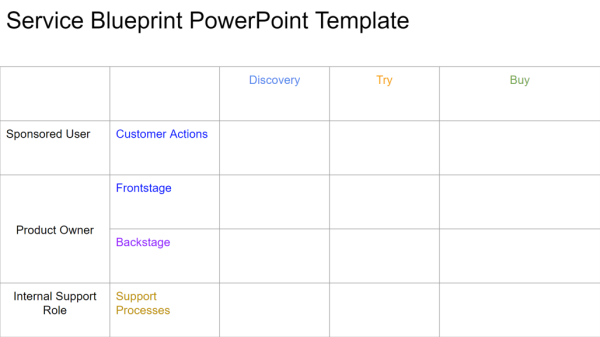
Service Blueprint Template PDF
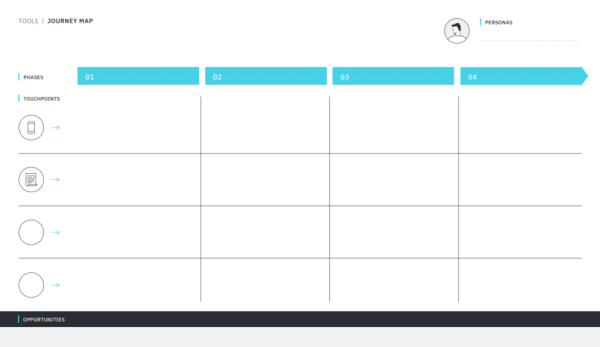
Benefits of using Service Blueprints
Services are not tangible therefore it’s difficult to convince executives and decision-makers that changes have to be made. It’s even difficult to talk about some changes without a complete picture of the process. Interaction in the process and visualizing every step highlights areas that need improvement and decreases vagueness. Service blueprints optimize processes and empower organizations. Some other benefits of service blueprints are:
- Flexibility and Scalability
Service blueprints contain as little or as much detail as needed. They enable high-level overviews.
- Knowledge transferability and Cross-functionality
Managers and employees in complex processes or long-standing processes can lose sight of a complete picture or the way actions affect departments, customers, and fellow employees. Service blueprints reduce siloes and clarify interactions.
- Competition
Service blueprints enable you to make a comparison of your desired services to look like with the way they look now, or you can make a comparison with the services of a competitor.
- Failure analysis
After you can see who does what, it will be easier for you to diagnose the problem.
Service Blueprint Online Tools
Miro
Use Miro’s Service blueprint template to enable the designing and understanding of service experience and to find ways to improve.
FigJam
FigJam’s templates can enable your team to create a better customer experience. Using this template you can get the job done right.
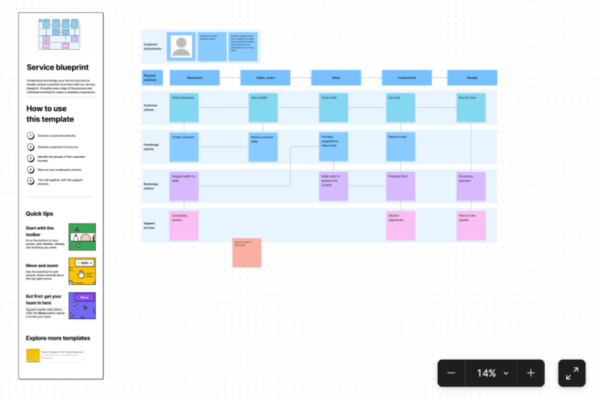
Lucidchart
The Lucidchart Service Blueprint template helps design the blueprint of your process. To be able to make changes and innovate, you need to use this template and visualise each actor and step from third-party vendors to customers.
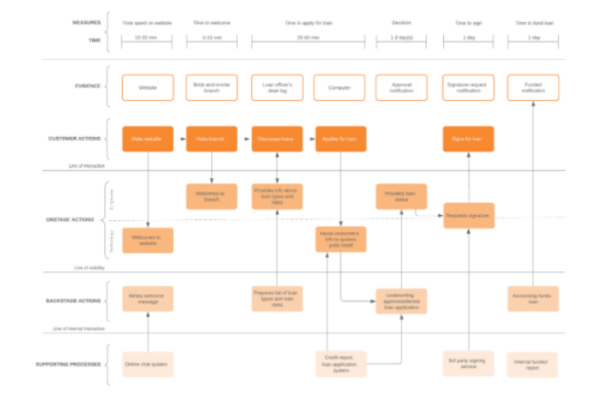
Creately
Plan and improve your service’s customer experience by using this creately template from start to finish.
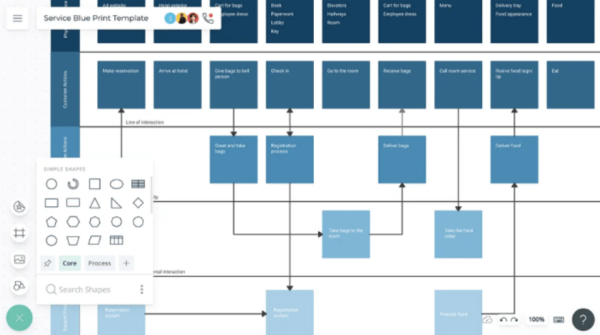
Mural
The Mural template enables the creation of visual maps and touchpoints. It allows teams to visualise the service and get a better understanding of the moving parts. The template can be duplicated and used in projects.
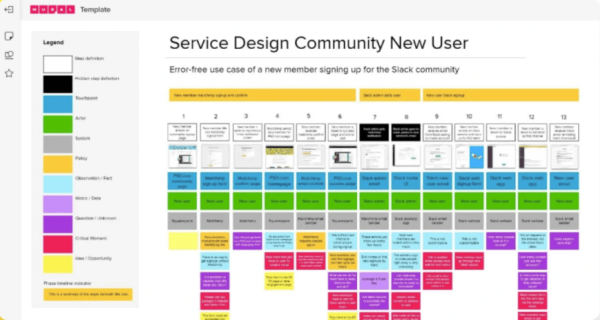
Service Blueprint Best Practices
- Customer scenario
Whether you create a new process or map an existing one, start with a scenario of customer service that you want to explore. It’s beneficial to include customers and ensure that the scenario is true.
- Customer experience
Plot actions of the scenario for the customers in chronological order.
- Customer’s actions
After you lay out the customer service experience, add backstage and frontstage actions, physical evidence, support processes, and time to the actions.
- Lanes of action and responsibility
Use lines of separation to keep the categories in their lane and to illustrate the interaction of actors during the service process.
- Cross-functional relationships
After category mapping, add details to the service blueprint using arrows. You can ten show the dependencies and relationships across different categories using arrows. A single arrow shape has an exchange that occurs in the indicated direction. A double arrow indicates a reached agreement or the dependence of the activities on each other.
Service Blueprint FAQs
Which is the most important component in a service blueprint?
The most important component in a service blueprint is the arrows. They indicate dependencies and relationships. A single arrow indicates a linear exchange and a double arrow suggests codependency and agreement.
What is the main strength of the service blueprint?
It gives a full picture of the way a service and an experience are delivered, front to back, end to end, and across channels. It enables a high-level view of user experience and a detailed view of things going on below the surface.
What are customer actions in the service blueprint?
Customer actions are the swim lane in the service blueprint. They outline the acts of the user during the interaction and should be aligned with phases. Between the frontstage actions and the customer actions is the line of interaction.
How might a service blueprint be used for operations decisions?
A blueprint enables the improvement of the design of an existing service or designing of a new service. When they have an explicit current operation, managers know the way they will operate in future.

